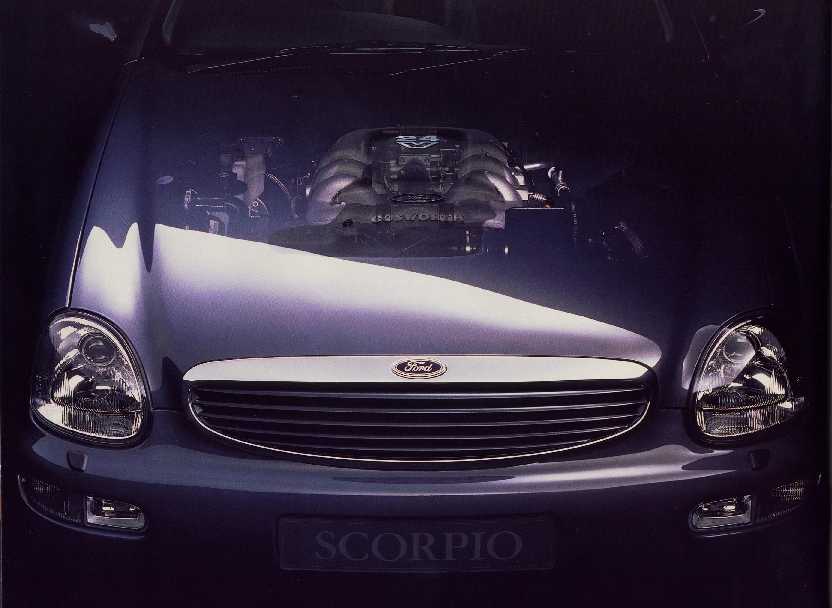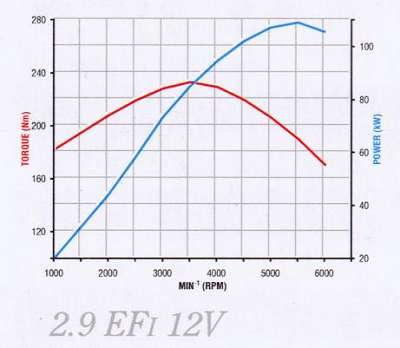
In messages on the Confidential List some owners have complained
of a 'flat spot' in power delivery between 3000 to 3500 rpm and have been asking
if their cars have a fault which needs repairing. It is not that the engines
have been running badly, it is just that the engine does not seem to deliver
power when it is expected. The engine picks up, but after a moment of delay.
The answer lies with the Variable Resonance Inlet System (VIS) which enhances
torque at higher engine speeds.
V6 Cologne (2.9 12V)
Below is the 12V torque/power graph for the 12V V6 Cologne engine. This has 2
hydraulically-operated valves per cylinder and a standard inlet manifold. Of the
two plots, the Torque line is of more interest because the automatic gearbox
uses the torque of the engine to transmit power to the wheels, not horsepower.
Maximum power of the engine is delivered at 5,600rpm, but these revolutions will
never be normally be reached: instead the engine rises to the revs at which it
delivers maximum torque, at about 3,600rpm and stays there while power is
required, before falling away as the accelerator is lifted and the torque
converter clutch engages. At cruising speed the engine will be spinning at or
slightly under 3,000 rpm and still developing 225 Nm of torque. The engine is
still on an upward power curve and it will easily meet further torque demand
from the gearbox. This is what gives the engine that wonderful 'grunt' which I
so enjoyed in my previous three 12V Granadas.

24V Cosworth
With the Cosworth 24V engine in the Scorpio the engine benefits from four cams
and 24 hydraulic valves. Because of their breathing characteristics, multi-valve
engines tend to develop more power higher in the rev band, which is bad for
economy, and to counteract this Cosworth developed a variable inlet system. See
VIS. Restricting one of the inlet valves at lower revs
(below 3,200 rpm) and using resonance techniques in the inlet, as well as better
porting, Cosworth have produced a much steeper power curve from the same
capacity. See the diagram below.

Already, below 3,200 rpm the 24V has pushed up the Nm from 225
on the 12V to over 260 Nm and this is developed to coincide with a cruising
speed of up to 90 mph. There is ample power to breast hills, however steep, even with
a full load of passengers and fuel - this is cruising at its most relaxed.
Beyond 3200 rpm, however, there is a drop in torque which is caused by changes
in the inlet manifold as the VIS valve opens and the secondary resonance is
established. This lasts for only about 500 rpm, and then the engine is once
again at the bottom of a very steep power curve in which the Nm soars from 253
Nm to 281 Nm in only 700rpm. This is an impressive achievement - only 12 Nm less
than the 2.5 litre turbo diesel - indeed, at the time of its introduction this
engine was the most powerful normally aspirated sub-3 litre petrol engine in the
world. This is the reason for the exhilarating surge in acceleration which can
leave so many cars behind, floundering in its wake.
However, it needs a slight change in driving style to accommodate this
characteristic. While cruising at 80 mph, for example, the driver faces a delay
of 700 rpm between single inlet operation and the onset of the double. If he
just depresses the accelerator the car will only slowly gain speed - the torque
of the engine is on a downward curve and it feels almost sluggish.
Instead, the driver should flick the car out of overdrive 4th. Immediately, the
revs rise by 500 rpm, and if the driver now smoothly matches the revs with the
road speed the engine is poised at 3,600 rpm, exactly at the bottom of the next
power curve, ready to unleash that incredible surge of Cosworth quad-cam power.
Gently depressing the accelerator now delivers a immense surge of torque which
is such an incredible experience for the new owner - and remains available to
140 mph.
This is not even using kickdown! From rest, if the driver buries his right foot
into the carpet, the EECV Powertrain Control Module detects a Wide Open Throttle
(WOT). It automatically times the injectors to a rich mixture and switches off
the air conditioning compressor clutch to reduce engine load, while the EGR
valve closes to allow a full air/charge mixture and the torque converter clutch
unlocks to allow the torque converter to spin up to maximum torque delivery. The
engine pours its torque into the converter and the variable inlet opens as soon
as the rev band is reached. At the rate the revs are increasing the VIS
changeover is almost unnoticeable: now the engine note rises to a formula one
howl, the back axle has settled on its springs and the bonnet has lifted
slightly and the speedo needle is sweeping through to the limit - your
passenger's eyes are agape with astonishment and his head is jammed back against
his headrest. His words are normally unprintable ...
DOHC Power Delivery
The 24V is not the only recipient of VIS - the DOHC2000 16V engine also uses
variable inlets to enhance torque delivery. Below is the power chart of the DOHC
8 valve. Here, the torque is a relatively flat curve peaking at 166 Nm at only
2,500 rpm. This torque remains above 160 Nm until 4,600 rpm, when it tails off
fairly quickly. The 8 valve Scorpio was only available with manual transmission,
and the power (KW) curve shows a healthy line from 30 Kw at 1500 rpm to 84 Kw
(115 bhp) at 5,600 rpm.

Now, below, the result of four valves and VIS on the DOHC engine. For the manual
engine (although timings can be programmed differently into the EECV depending
on the transmission) the power graph shows an almost straight progression up to
100 Kw (136 bhp) at 6,400 rpm. In any manual gear the driver will have a smooth
progression of power available as the revs rise.

Here, to a less marked degree, the influence of the VIS has a similar effect. At
3,600 rpm the single inlet had done its work and has given its best. The torque
produced by the engine would continue to fall now through the remaining revs on
the engine, but at 3,600rpm the second inlet opens, both the inlet valves are
now admitting resonating air and the torque rises swiftly to 175 Nm at only 4250
rpm. Again, this is a useful boost in torque available to the driver of the
automatic - it is welcome extra 'grunt' that he will be able to use on
overtaking and breasting hills.
2.3 DOHC
Regrettably, the publicity brochure from which I obtained these power graphs
does not show the 2.3 engine - it was introduced to the range a full year later.
I have another brochure which covers the 2.3, but in this publication the power
graphs have been omitted altogether. On this engine, Ford claimed that the new
composite material inlet manifold was so efficient that it did not need the VIS
system and it would have been nice to see if this was the case. The maximum
power of the 2.3 is 147 bhp. @ 5,600 rpm.
If you have a brochure which does show a 2.3 power graph, please let me know.
2.5 VM TDi
The Vittori 2.5 turbo diesel was only available with a manual transmission until
the last 8 months of production in 1998, when an automatic was introduced. The
graph above appears to be a little generous to the earlier diesel - an uprated
VM engine was not introduced until September 1996.

As expected, being a compression-ignition engine, the torque curve rises steeply
to a maximum of 293 Nm at only 2200 rpm. Thereafter torque trails off sharply. A
driver would normally choose to keep the engine between 1750 and 2,500 rpm to
make maximum use of this torque. The power curve rises smoothly until 4,200 rpm,
where it is developing 82 Kw (125 bhp)
Graphs reproduced from December 1994 Scorpio brochure - Ford
Copyright.
EricR

![]()
